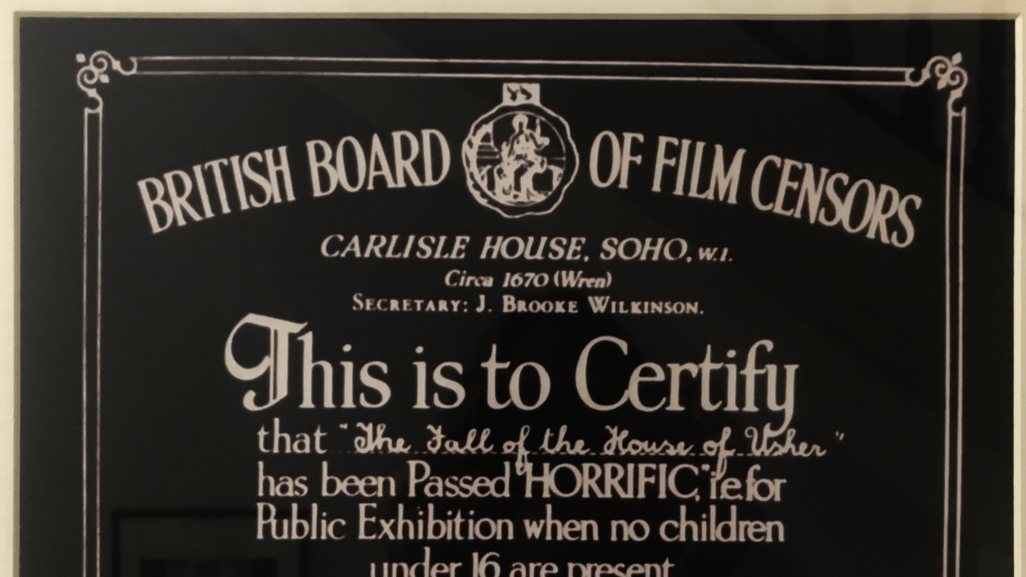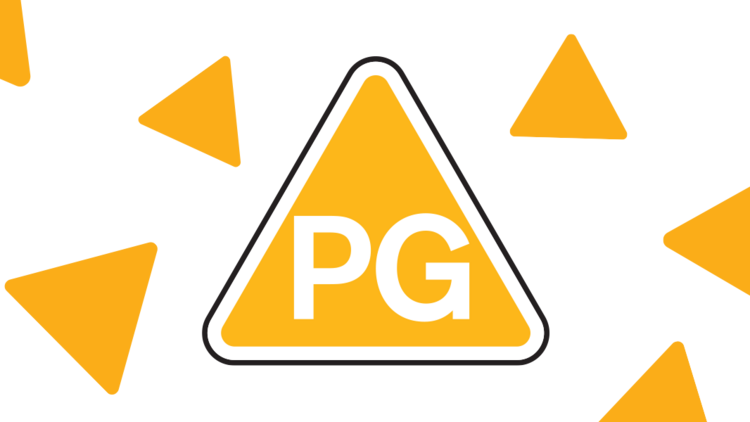
History of the BBFC
We’ve been classifying film in the UK for over 100 years and video for over 30 years, so we’ve got a lot of experience to draw on.
Discover our key moments, landmark decisions and legislation on our timeline.
Legislation
The Cinematograph Act arrives giving local authorities the power to provide or withhold licenses for cinemas in their region.
Legislation
The British Board of Film Censors is created by a burgeoning film industry as a means of ensuring uniformity for film classification decisions.
Drugs
BBFC's grounds for deletion extended to include 'the drug habit, e.g. Opium, Morphia, Cocaine etc...'
Legislation
The H certificate is introduced by the BBFC. H is an advisory certificate which tells the public that a film has a horror theme and is not suitable for children.

Drugs
Sequence in Chaplin's Modern Times shows the star becoming comically affected by inadvertently sniffing 'nose powder'. The film is passed U without cuts.
Drugs
Reefer Madness propagandises, in no uncertain terms, against young people trying marijuana.
Violence and Weapons
Brighton Rock is attacked by critics as 'nasty and sensationalist' but is a success at the box office.
1949
Screen legend Robert Mitchum is jailed for marijuana possession.
Legislation
As a result of changes to the Cinematograph Act, the X certificate is introduced. No children under the age of 16 are allowed to see an X film. This is the first mandatory age-restricted category.
Violence and weapons
The BBFC rejects The Wild One on the grounds that it presents an 'unbridled spectacle of hooliganism'. It is not rated until 1967.
Violence and weapons
The BBFC requires cuts to Rebel Without A Cause to remove a knife fight.
Drugs
The Man with the Golden Arm Frank Sinatra startles audiences by playing a heroin addict in a film based on a gritty cult novel by Nelson Algren. The BBFC awards the film an X certificate.
Legislation
In the first famous trial using the new Obscene Publications Act, D H Lawrence's novel Lady Chatterley's Lover becomes freely available for the first time in 32 years. The book is deemed art rather than pornography.
Violence and weapons
The BBFC rejects Lady In A Cage on the grounds that is an exercise in sadistic brutality and might 'have the effect of encouraging juvenile violence'. The film is later rated 18 uncut on video in 2002 and 15 uncut on DVD in 2005.
Drugs
LSD and marijuana are the drugs of choice with the counterculture. Rock stars Mick Jagger and Paul McCartney are arrested for possession of the latter. Roger Corman's The Trip, dealing with LSD use, is rejected by the BBFC.
Legislation
The age limit on the X category is raised from 16 to 18. The advisory U and A categories are introduced along with the AA category that allows admission to those aged 14 and over.
Drugs
Andy Warhol's Trash is rejected by the BBFC. It is subsequently passed X with cuts in 1972. Rising star Al Pacino appears in Panic in Needle Park, about heroin addicts in New York. The film is rejected by the BBFC and not rated until 1975.
Violence and weapons
Enter the Dragon is rated X for cinema release with cuts to violence, but with nunchaku (chainsticks) scenes intact. A Clockwork Orange is removed from sale by Stanley Kubrick after controversy about its violence and death threats against his family.
Violence and weapons
After reported outbreaks of violence involving martial arts weapons, BBFC Director James Ferman enforces a blanket ban on all sight of nunchaku and shuriken (throwing stars).
Violence and weapons
James Ferman recalls Enter the Dragon to cut nunchaku scenes. The Warriors is rated X uncut. Local authorities, concerned by reports of the film's effects in the US, ask the BBFC to reconsider. The BBFC declines.
Drugs
Cult German film Christiane F portraying heroin addiction is passed with an X certificate. The initial 18 rated video version is cut to reduce scenes of drug taking for home viewing in 1986. A later version in 2000 is passed 18 without cuts.
Legislation
The BBFC rating system is overhauled with the introduction of the PG, 15, 18 and R18 categories. The first film rated PG is Return Of The Soldier.
Violence and weapons
Streets of Fire is one of the last films to feature butterfly knives before they are added to the list of banned weaponry. The Video Recordings Act is introduced to prevent underage access to unsuitable videos and crack down on so-called 'video nasties'.
Drugs
The Video Recordings Act is passed with its 'special regard' for home viewing and the possibility of 'instruction' via the rewind facility.
Legislation
The Video Recordings Act (VRA) is passed and the BBFC becomes the designated authority for rating videos 'for suitability within the home'. The BBFC becomes the British Board of Film Classification.
Violence and weapons
Sight of a poster featuring Bruce Lee holding nunchaku is cut from No Retreat, No Surrender.
Drugs
Comic references to cocaine are cut from Crocodile Dundee for PG on video. Ecstasy is established as the drug of choice in the rave dance scene.
Violence and weapons
Outright ban on nunchaku, shuriken and balisong is waived in non-action/martial arts works where the sight is incidental, comic, brief and/or used to establish character. After the Hungerford Massacre, Rambo III is cut to reduce violence and knifes.
Legislation
Tim Burton's Batman becomes the first 12 rated film in the cinema. Children under 12 cannot view this in the cinema. This category is only available for theatrical releases.
Violence and weapons
Sight of an anthropomorphic turtle wielding a string of sausages in a manner similar to nuchaku is cut from Teenage Mutant Ninja Turtles II: Secret of the Ooze.
Violence and weapons
The James Bulger case prompts concerns about possible effects of video violence. Child's Play 3 is wrongly linked to the case and withdrawn from sale. Parliamentary discussion of the VRA delays release of Reservoir Dogs and other works.
Legislation
An amendment is made to the VRA in the wake of the Jamie Bulger case. The BBFC is asked to pay 'special regard to any harm that may be caused to potential viewers... or society...' in any given video or video game.
Violence and weapons
Natural Born Killers is rated 18 uncut after the BBFC investigates possible links between the film and killings in France and the USA. No link is found but after the Dunblane School Massacre, the distributor decides not to release the film on video.
Drugs
Trainspotting passed uncut on film. The film is, however, cut for its first outing on video.
Drugs
Liam Gallagher of rock group Oasis says taking cocaine is 'like having a cup of tea'.
Violence and weapons
The ban on martial arts weaponry is lifted. For the first time the BBFC publishes a set of written Guidelines which disallow emphasis and glamorisation of realistic contemporary and easily obtainable weapons but do not automatically ban any weapon.
2000
Enter the Dragon is rated 18 uncut on video. A Clockwork Orange is re-released in UK cinemas after Stanley Kubrick's death.
Violence and weapons
Lara Croft: Tomb Raider is cut for glamorisation of knives in a film aimed at young teenagers. Natural Born Killers is finally released uncut on video and DVD.
Drugs
Both the star and director of the gritty drugs-themed thriller Traffic win Oscars. The film sports an 18 uncut status in the UK.
Legislation
Following an extended period of consultation, the 12 category for cinema is replaced with the advisory 12A. The first film to sport the new category is The Bourne Identity.
Violence and weapons
Teenage Mutant Ninja Turtles II: Secret of the Ooze is rated PG uncut.
Drugs
Trainspotting is passed uncut for DVD release. Corman's The Trip is finally passed as suitable for adults to view.
Violence and weapons
Secondhand Lions is cut for PG on film (at the distributor's request) for sight of a flick-knife and instructions on how to hold such a weapon. The film was raised to 12 without cuts for its video and DVD release.
Drugs
City By The Sea, which contains an anti-drug message, was passed 15 on film in 2002. Expert advice was sought and the work is raised to 18 on video due to concerns that one particular scene could provide instructive detail about drug use.
Violence and weapons
The Passion of the Christ is rated 18 for extended scenes of strong violence. Complaints are received saying that it should have a received a lower rating.
Drugs
Andy Warhol's Trash is passed 18 uncut for DVD release. Cannabis is legally reclassified from a Class B to a Class C drug.
Violence and weapons
Sin City, based on a series of graphic novels by Frank Miller, is rated 18 for strong vigilante violence.
Drugs
Magic Roundabout is passed U after the oblique drug references were deemed innocuous and unlikely to be understood by children.
Violence and weapons
Casino Royale is rated 12A and 12 despite some scenes of violence and torture. Complaints are received saying that it should have been 15.
Drugs
Harsh Times and Kidulthood are passed 15 because the portrayal of drug use in both films was thought to be aversive.
Violence and weapons
Horror film 30 Days of Night is rated 15 on film for scenes of strong bloody violence, but the category is raised to 18 for DVD release.
Drugs
Things We Lost In The Fire contains scenes of heroin preparation and use, however the film as a whole has a strong anti-drug message and is passed 15.
Drugs
Pineapple Express is cut to achieve the requested 15 category. A scene showing drug dealing to schoolchildren and cannabis smoking between them and the sellers was reduced. The uncut video version is raised to 18.
